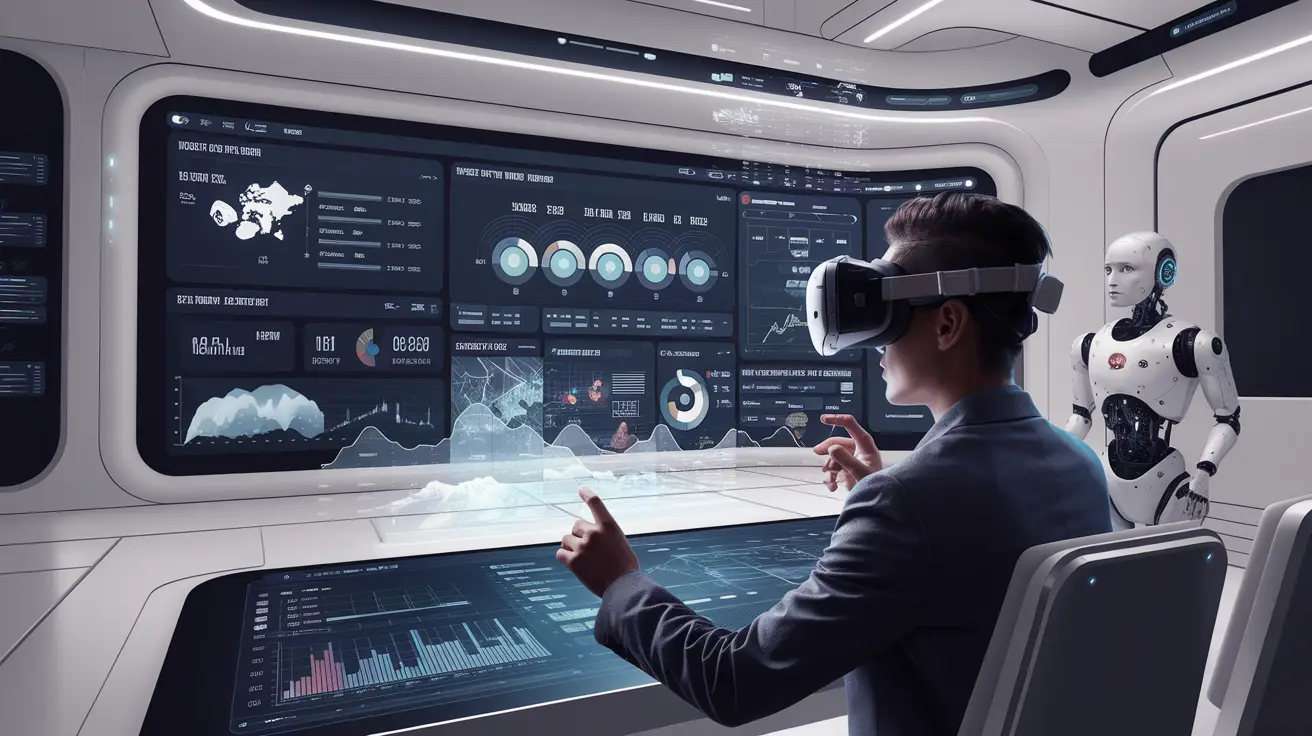
Revolutionizing Data Visualization: The Rise of Large Action Models in Modern Analytics
Data visualization has long been a critical component of data analysis, allowing individuals and organizations to make sense of complex information through visual representation. In recent years, there has been a significant shift towards the use of large action models in modern analytics, revolutionizing the way data is visualized and interpreted. These innovative models are capable of processing vast amounts of data at unprecedented speeds, providing deeper insights and more intuitive interactions with complex datasets.
In this article, we will explore the rise of large action models in data visualization and how they are transforming the field of analytics as we know it.
The Evolution of Data Visualization
Data visualization has come a long way since its inception, evolving from simple charts and graphs to sophisticated models capable of handling massive datasets. With the rise of large action models in modern analytics, data visualization has taken on a whole new level of complexity and functionality. These advanced models are able to process enormous amounts of data quickly and efficiently, providing users with deeper insights and more interactive experiences.
One key aspect of this evolution is the increasing emphasis on real-time visualizations that allow for instant updates as new data comes in. This shift towards dynamic visualizations enables organizations to make faster decisions based on up-to-date information, leading to improved outcomes and greater efficiency. Additionally, these large action models have made it easier for users to interact with complex datasets through intuitive interfaces, making it possible for individuals at all levels of expertise to glean valuable insights from their data.
In conclusion, the evolution of data visualization through the use of large action models marks a significant turning point in how we analyze and interpret information. As technology continues to advance at a rapid pace, we can expect even more innovative approaches to emerge in this field, further enhancing our ability to derive meaningful insights from vast amounts of data. The future holds exciting possibilities for the continued evolution of data visualization techniques, revolutionizing how we understand the world around us.
The rise of large action models in modern analytics represents a significant shift towards processing vast amounts of data at unprecedented speeds, providing deeper insights and more intuitive interactions with complex datasets.
Understanding Large Action Models
Understanding large action models is crucial for anyone involved in data analysis and visualization. These advanced models have the capability to process immense amounts of data rapidly, allowing for more in-depth insights and a deeper understanding of complex datasets. By utilizing large action models, individuals and organizations can make better decisions based on accurate and comprehensive information.
Large action models are transforming the field of modern analytics by revolutionizing how data is visualized and interpreted. These innovative models enable users to interact with data in a more intuitive manner, uncovering patterns and trends that may have been previously hidden. As technology continues to advance, it is essential for professionals in the field of data analysis to stay up-to-date on these developments in order to maximize the potential benefits of large action models in their work.

Benefits of Large Action Models in Modern Analytics
Large action models in modern analytics offer a multitude of benefits that are revolutionizing the way data is visualized and interpreted. One of the key advantages of these models is their ability to process vast amounts of data quickly and efficiently. This allows organizations to gain deeper insights from their data in real-time, leading to faster decision-making and more informed strategies.
Additionally, large action models enable more intuitive interactions with complex datasets, making it easier for individuals to explore and understand their data. By visually representing data in a clear and interactive manner, these models help users uncover patterns, trends, and relationships that may have otherwise gone unnoticed. This not only enhances the overall analysis process but also improves communication within organizations by presenting complex information in a digestible format.
Overall, the rise of large action models in modern analytics is transforming the way individuals and organizations approach data visualization. By harnessing the power of these innovative tools, businesses can unlock valuable insights from their data at a rapid pace, ultimately improving decision-making processes and driving business success.
Real-world Applications of Large Action Models
Large action models have a wide range of real-world applications across various industries. For example, in finance, these models can be used to analyze market trends and make strategic investment decisions based on real-time data visualization.
In healthcare, large action models can help researchers identify patterns in patient data to improve treatment outcomes and population health management. Additionally, in marketing and e-commerce, these models can be utilized to personalize user experiences, enhance customer engagement, and drive sales through targeted advertising campaigns.
Furthermore, large action models are also being applied in the field of transportation and logistics to optimize route planning, reduce fuel consumption, and improve overall operational efficiency. By visualizing complex supply chain networks and traffic patterns, organizations can better understand areas for improvement and make data-driven decisions to streamline their operations. Overall, the use of large action models in modern analytics is transforming how businesses leverage data to gain competitive advantages and drive innovation across various sectors.
Challenges and Limitations of Large Action Models
While large action models have certainly revolutionized data visualization, they also come with their own set of challenges and limitations. One major challenge is the complexity of these models, which can make them difficult to understand and interpret for individuals who are not well-versed in advanced analytics techniques. This can lead to potential misinterpretation of results or missed insights that could be crucial for decision-making.
Another limitation of large action models is the computational resources required to run them effectively. These models often require significant computing power and storage capabilities, which may be costly or inaccessible for smaller organizations or individuals without access to high-performance computing infrastructure. As a result, there may be a barrier to entry for those looking to leverage the benefits of large action models in their data analysis efforts.
Overall, while large action models offer immense potential for enhancing data visualization and interpretation, it is important for users to be mindful of the challenges and limitations associated with implementing these advanced analytical techniques. By understanding these factors and taking steps to mitigate them through appropriate training, investment in resources, and collaboration with experts in the field, organizations can fully harness the power of large action models in modern analytics endeavors.
Enhancing Data Interpretation with Large Action Models
Enhancing data interpretation with large action models is becoming increasingly important in the field of data analysis. These models go beyond traditional methods of visualization, allowing for more interactive and intuitive ways to explore complex datasets.
By leveraging the power of large action models, individuals and organizations can uncover hidden patterns, trends, and relationships within their data that may not be immediately apparent through traditional means.
The rise of large action models in modern analytics has revolutionized the way we approach data visualization. With the ability to process vast amounts of information at lightning speed, these models enable users to quickly gain deeper insights into their data and make more informed decisions.
As technology continues to evolve, we can expect to see even greater advancements in how we interpret and analyze data using these powerful tools. Ultimately, embracing large action models in data interpretation will lead to more efficient problem-solving and a clearer understanding of our ever-increasing volumes of information.


Implementing Large Action Models in Data Visualization
Implementing large action models in data visualization is a game-changer in the world of modern analytics. These advanced models allow for the processing of massive amounts of data at lightning-fast speeds, enabling deeper insights and more intuitive interactions with complex datasets.
By utilizing large action models, individuals and organizations can uncover patterns and trends that were previously hidden within their data, leading to more informed decision-making and a competitive edge in today’s fast-paced business environment.
One key benefit of implementing large action models in data visualization is the ability to create interactive visualizations that allow users to explore their data in a dynamic way. These interactive features make it easier for users to drill down into specific areas of interest, manipulate variables, and gain a deeper understanding of their datasets. This level of flexibility and interactivity not only enhances the overall user experience but also improves productivity by streamlining the analysis process. As technologies continue to evolve, incorporating large action models into data visualization tools will become essential for staying ahead in an increasingly data-driven world.
Overall, the rise of large action models in modern analytics represents a significant advancement in how we visualize and interpret complex information. By leveraging these powerful models, organizations can extract valuable insights from their data more efficiently than ever before. As we continue to harness the potential of these innovative tools, we can expect to see even greater advancements in data visualization capabilities that will revolutionize our ability to understand and leverage big data effectively.
Optimizing Performance of Large Action Models
Optimizing performance of large action models is crucial in ensuring that they can effectively handle the vast amounts of data being processed. One way to optimize performance is through efficient algorithm design, which involves carefully considering how different parts of the model interact and making adjustments to improve overall efficiency.
This may involve optimizing computation and memory usage, reducing redundant calculations, or streamlining processes for faster execution.
In addition to algorithm design, hardware acceleration can also play a significant role in improving the performance of large action models. By leveraging specialized hardware such as GPUs or TPUs, models can benefit from increased processing power and speed up complex computations. Additionally, distributed computing techniques like parallel processing can further enhance performance by dividing tasks among multiple processors or nodes, allowing for more efficient utilization of resources and faster completion times.
Overall, optimizing the performance of large action models requires a combination of careful algorithm design and leveraging advanced hardware capabilities. By continually refining these aspects and exploring new technologies, organizations can maximize the potential insights gained from their data visualization efforts while enhancing overall efficiency and productivity in modern analytics practices.
The Future of Data Visualization with LAMs
The future of data visualization with large action models is promising and exciting. These advanced models have the ability to handle massive datasets in real-time, allowing for more dynamic and interactive visualizations that can uncover insights that were previously difficult to detect. With the increasing complexity of data sources and the need for quick decision-making, these large action models will play a crucial role in modern analytics.
As organizations continue to collect vast amounts of data from various sources, the demand for more sophisticated data visualization techniques will only continue to grow. Large action models offer a solution that allows users to not only visualize data but also interact with it in ways that were not possible before. This shift towards more powerful and efficient data visualization tools will ultimately lead to more informed decision-making processes and a deeper understanding of complex datasets. The future of data visualization with large action models is bright, as these innovative tools pave the way for a new era of analytics.

The Future of Data Visualization with LAMs
Data visualization has always played a crucial role in helping people understand and derive insights from complex datasets. However, with the advent of machine learning technologies, data visualization has entered a new era where large action models are being used to revolutionize the field of modern analytics. These advanced models have the ability to process massive amounts of data quickly and efficiently, allowing for deeper analysis and more intuitive interactions with complex datasets.
By leveraging machine learning algorithms in data visualization, organizations can uncover hidden patterns and trends that may not be easily discernible using traditional methods alone. This allows for better decision-making based on data-driven insights, ultimately leading to improved business outcomes. With the rise of large action models in modern analytics, we are witnessing a transformation in how data is visualized and interpreted, paving the way for more advanced and sophisticated approaches to analyzing information effectively. As technology continues to evolve, we can expect further innovations in this space that will continue to shape the future of data visualization as we know it today.
The Future of Data Visualization with LAMs
Data visualization has always played a crucial role in helping individuals and businesses understand the vast amounts of data at their disposal. With the advent of large action models, this process has been revolutionized, allowing for more interactive and intuitive ways to manipulate and interpret data. These models are able to handle massive datasets with ease, providing users with deeper insights into trends and patterns that may not have been apparent before. By combining advanced algorithms with powerful computational capabilities, large action models are changing the way we approach analytics.
One of the key advantages of using large action models in data visualization is their ability to process information quickly and efficiently. This speed allows users to interact with complex datasets in real-time, making it easier to explore different perspectives and uncover hidden relationships within the data. Furthermore, the intuitive nature of these models makes them accessible to a wider range of users, regardless of technical expertise. As organizations continue to collect vast amounts of data from various sources, leveraging large action models will be essential in gaining actionable insights that can drive informed decision-making.
In conclusion, the rise of large action models in modern analytics is transforming how we visualize and interpret data on a whole new level. With their ability to handle massive datasets quickly and intuitively, these models are enabling organizations to extract valuable insights that were previously out of reach. As technology continues to advance at a rapid pace, utilizing these cutting-edge tools will be vital for staying ahead in an increasingly data-driven world.
Ethical Considerations in Data Visualization with Large Action Models
As data visualization with large action models becomes more prevalent in modern analytics, ethical considerations become increasingly important. One major concern is the potential for biases to be reinforced or perpetuated through these models, leading to inaccurate or discriminatory results. It is crucial that those developing and utilizing large action models remain vigilant in identifying and mitigating biases within their datasets and algorithms to ensure fair and unbiased visualizations.
Another ethical consideration in data visualization with large action models is the importance of transparency and accountability. As these models become more complex and powerful, it can be difficult for users to understand how they arrive at their conclusions or recommendations. It is essential for organizations to clearly communicate the limitations of their models, the assumptions made during analysis, as well as any potential risks associated with relying on these visualizations for decision-making purposes. Maintaining transparency helps build trust with users and ensures that decisions are made ethically based on accurate information presented through data visualization tools.
Case Studies of Successful Data Visualization using Large Action Models
One successful case study of data visualization using large action models is the collaboration between NASA and Google. NASA’s Earth Science Division teamed up with Google Cloud to create a platform called Earth Engine, which utilizes large action models to process and visualize petabytes of satellite imagery data. This partnership has allowed researchers and scientists to analyze complex climate data on a global scale in ways that were previously unimaginable. By leveraging the power of large action models, they are able to track changes in land use, monitor deforestation patterns, and even predict natural disasters with greater accuracy.
Another notable example of successful data visualization using large action models comes from healthcare organization Kaiser Permanente. By implementing advanced analytics tools powered by large action models, Kaiser Permanente has been able to identify trends in patient outcomes, improve operational efficiency, and personalize treatment plans for individual patients. These visualizations have not only helped healthcare providers make more informed decisions but have also enabled patients to actively participate in their own care by understanding their health data through intuitive graphics and interactive dashboards. The use of large action models has transformed the way healthcare data is analyzed and presented, leading to better patient outcomes and cost savings for the organization as a whole.
Overall, these case studies demonstrate the immense impact that large action models can have on enhancing data visualization capabilities across various industries. As technology continues to advance at a rapid pace, it is clear that integrating these innovative techniques into modern analytics workflows will be crucial for driving meaningful insights and improving decision-making processes based on complex datasets.
Conclusion: The Impact of Large Action Models on Modern Analytics
In conclusion, the impact of large action models on modern analytics cannot be understated. These advanced models have transformed the way data is visualized and analyzed, allowing for more efficient processing of vast amounts of data in real-time. By leveraging these innovative tools, organizations can gain deeper insights into their data and make more informed decisions.
Furthermore, the rise of large action models has paved the way for new possibilities in data visualization and interpretation. With the ability to handle complex datasets with ease, analysts can uncover hidden patterns and trends that were previously obscured. This enhanced capability has opened up a world of opportunities for businesses looking to stay ahead in a rapidly evolving market landscape.
Overall, it is clear that large action models have revolutionized modern analytics by providing faster processing speeds, deeper insights, and more intuitive interactions with data. As technology continues to advance at a rapid pace, we can expect even greater advancements in this field that will further shape how organizations leverage data to drive success.



Leave a Reply
You must be logged in to post a comment.